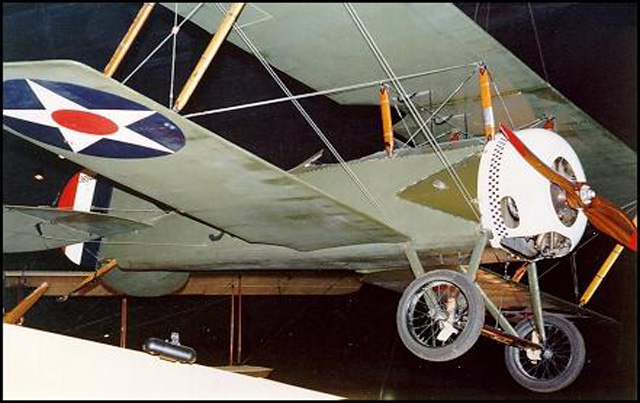
1918 Thomas Morse Scout
The Thomas Morse Scout became the standard single-seat fighter trainer used by the U.S. Air Service during World War I and was nicknamed the “Tommy” by the pilots who flew it.
Starting in 1917, it was used stateside as an advanced trainer. First models were delivered with the 100 hp Gnome rotary engine, and a slightly modified version was later made with the 80 hp Le Rhône rotary engine. Less than 500 examples were built.
After the war ended, many were sold as surplus to civilian flying schools, sportsman pilots, and ex-Army fliers. Some were used in the early 1930s for World War I films.
This aircraft was built with the 100 hp Gnome rotary engine and was acquired in 1997 from the Crawford Museum in Cleveland, Ohio. This will be a great project to restore back to flying condition. At some point the wings were “restored” for display purposes only and will have to be completely rebuilt. Most of the other components look usable for a restoration to flying condition. This is one of less than a dozen Tommys left in existence.
Specifications
- Year Built — 1918
- Wingspan — 20’6″
- Cruise Speed — 97 mph
- Gross Weight — 1,354 lbs
- Engine — Gnome Rotary (100 hp)
- Armament — One .30 caliber Marlin machine gun
Kermit’s Comments
The Gnome rotary engine, used in this aircraft, does not have a throttle. A fuel lever in the cockpit allows the pilot to control fuel going into the engine. Because there is no carburetor, there is no real way to properly control the fuel mixture. The pilot has only two choices for power: FULL THROTTLE or NONE!
The way the pilot controls the engine speed is with a “blip” switch located on top of the control stick. By holding the switch down with his thumb, the magneto is grounded, which shuts electricity off to the spark plugs. This effectively “kills” the engine. When the “blip” switch is released by taking the thumb off the switch, the spark plugs begin to fire again and the engine roars to life. By blipping the switch “ON” (thumb up) and “OFF” (thumb down), the pilot can control the speed of the engine for operation on the ground and to slow down for landing.